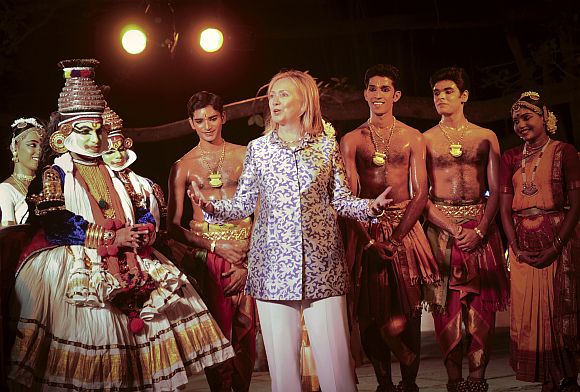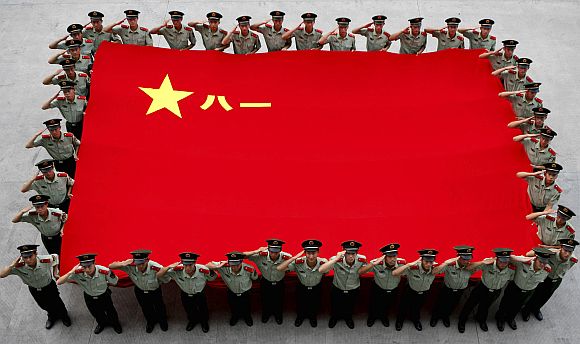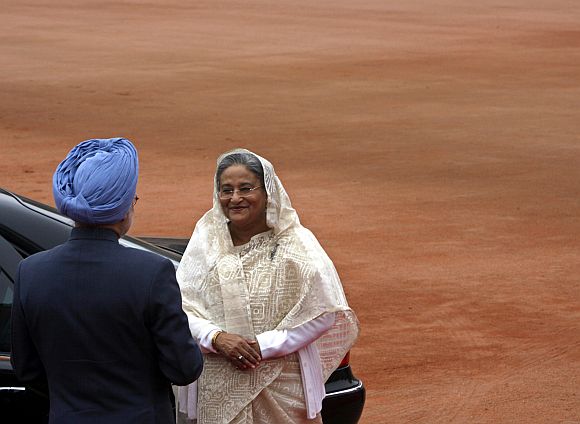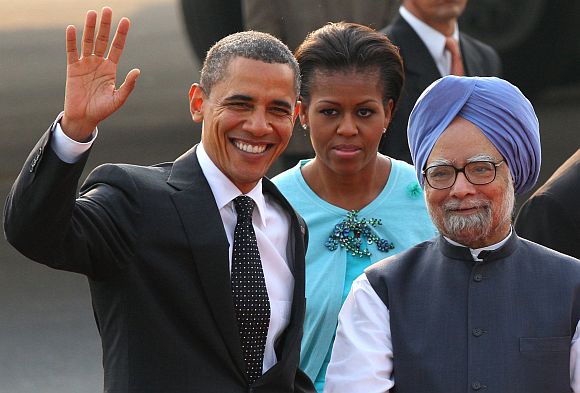Photographs: Reuters
United States Deputy Secretary of States William J Burns addressed a lecture on 'US-India partnership in an Asia-Pacific century' at the University of Pune on Friday. We present edited excerpts from his speech.
It is truly an honour to be here with all of you. With its half-million strong student body, its proud history and its cutting-edge research -- the University of Pune, like India itself, is a place of irrepressible energy and limitless promise.
I can think of no better place to address the enormously important issue of US-Indian partnership, and in particular the question of what the rise of the Asia-Pacific region -- emerging more and more as the center of gravity in global affairs -- means for the partnership between our two great nations.
Let me start with a simple premise. As US President (Barack) Obama told India's Parliament one year ago: "the United States not only supports India as a rising power; we fervently support it, and we have worked to help make it a reality."
Indeed, we are counting on India's rise as a global power -- one that engages from the Middle East and East Asia to Africa and beyond. The Obama administration has high hopes for the US-India relationship, and we are working hard to ensure that our ambitions are matched by results.
Today, I want to address what I hope will become a defining dimension of the US-India partnership: our work together to support the emergence of an Asia-Pacific region defined by security, prosperity and human dignity for all its people.
As you graduate and begin careers across India and perhaps across the world, the Asia-Pacific region is emerging as the epicenter of economic growth, innovation and global trade.
You will inherit a world shaped and led by this region. You therefore have an immense stake, nationally and personally, in how it develops in the coming years.
So the question is not whether the United States and India have an interest in working together in the Asia-Pacific. The question is whether we are doing as much as we can to ensure that our partnership in Asia realises its full promise. I believe the honest answer is: not yet.
The truth is that calls for US-India cooperation in the Asia-Pacific have not always been especially well-defined, or at least not always matched by clear prescriptions for what this means in practice. The rhetoric tends to outpace the reality. We can and should do better.
So I want to use my remarks today to try to clarify the contours of the challenge ahead: to explain why American foreign policy, like India's, will increasingly focus on the Asia-Pacific; to dispel a few misconceptions; and finally, to talk about how our two nations can and must work together to help ensure security, prosperity and human dignity for this dynamic region, whose eastern and western rims we occupy.
Please ....
'US, India to strive for democracy and prosperity in Asia-Pacific'
Image: PM Singh with US President Obama in New DelhiPhotographs: Reuters
So let us start with why the Asia-Pacific is so important. Stretching from India to the western coast of the Americas, this region is home to half the world's population. It has witnessed unprecedented levels of economic growth, leading to reductions in poverty without parallel in human history.
But the Asia-Pacific is also home to military buildups, nuclear proliferation, piracy, trafficking, natural disasters, and serious environmental and ecological challenges. Simply put, there is no more dynamic part of the world today, and no region more consequential in the decades ahead to American interests, to the shape of the global system, and if I may say so, to India's own future.
As the United States renews and reinforces our longtime role as a Pacific power, I know that some will question America's staying power. But they should remember that generations of Americans have sacrificed -- alongside their partners across the ocean -- so that democracy and prosperity could take root in the Asia-Pacific region.
We remain as committed as ever to advance these objectives. The United States has always been a Pacific nation, and we have strengthened and reaffirmed our Pacific alliances.
Many of India's strategic thinkers feel the same way on the magnetic pull of an Asia-Pacific century. India's distinguished former Foreign Secretary Shyam Saran, has observed that India's engagements with the Association of Southeast Asian Nations, China, Japan and Australia are "a reflection of the concept of the Asia-Pacific, which hitherto excluded India, expanding westwards to encompass the subcontinent as its integral part."
'We both have much to learn from each other'
Image: US Secretary of State Hillary Clinton greets Indian dance performers during her visit to ChennaiPhotographs: Reuters
As we consider what a US-India partnership in this region should look like, we should assess first where our interests most converge: our undeniable shared interest in a peaceful and secure Asia-Pacific -- defined by rules, norms and patterns of behaviour that favour openness -- to ensure the peaceful, long-term prosperity that is so vital to our nations' growth.
Secretary (of State Hillary) Clinton posed two questions in Chennai this past July: Will this region adopt basic rules of the road -- or of the sea, for that matter -- to mobilise strategic and economic cooperation and manage disagreements? And will it build the regional architecture of institutions and arrangements to promote openness, trade, rule of law, human rights, and accountable governance?
While each of us approaches this partnership with our own set of near-term expectations, our shared interests give us a strong incentive to make sure that resilient norms are developing that reflect our shared values and interests, and that the regional architecture in the Asia-Pacific is delivering results.
That's why, last year, our two countries launched a strategic dialogue on the Asia-Pacific to ensure that the world's two largest democracies pursue strategies that reinforce one another.
We both have much to learn from each other, and dialogue offers an opportunity to identify new areas of cooperation and to address areas of disagreement.
We are also launching a new US-India-Japan trilateral consultation on regional issues. We understand the importance and effectiveness of multilateral approaches to regional and global issues, and appreciate India's growing participation and leadership role in these efforts.
We hope that India will join us in working to strengthen key Asian regional institutions -- from the East Asia Summit to ASEAN.
'India has shown great leadership in the efforts to confront piracy'
Image: A handout photo shows a pirate vessel after it was blown up by an Indian Navy warship in the Gulf of AdenPhotographs: Reuters
One issue of crucial economic and strategic importance is maritime security. Like the United States, India has an enduring interest in freedom of navigation, the free flow of commerce, and the peaceful resolution of disputes.
The oceans are key to India's security and prosperity, as they are to ours. While India is nearly a continent unto itself, it still trades like an island.
By volume, 90 per cent of the goods it trades are carried by sea. We welcome and support India's growing naval capacity and modernisation and its engagement across Asia. India's strong presence across the Indian and Pacific Oceans is a source of comfort and affirms its potential as a net security provider in the maritime domain.
Toward this end, the United States is interested in working with India as we develop our own approach to the variety of opportunities and challenges in the Indian Ocean region.
As we explore future maritime security cooperation, we can build on what we have already begun to do together to improve our efforts to counter piracy, improve maritime domain awareness and offer assistance and disaster relief.
Already in the Western Indian Ocean region, New Delhi is demonstrating its growing maritime capabilities with a robust counter-piracy approach that serves common regional interests.
As a founding member of the international Contact Group on Piracy off the Coast of Somalia, India has shown great leadership in the efforts to confront and roll back piracy that emanates from Somalia and threatens trade flows to and from Asia.
'US focus on Asia not to contain China'
Image: Paramilitary policemen salute as they hold a Chinese PLA flag to celebrate the anniversary of the founding of the PLA in Hangzhou, ChinaPhotographs: Reuters
The United States commends Indian efforts that have included naval ship deployments to the Gulf of Aden, escorting ships through unsafe waters, and stopping numerous pirate attacks. We recognise that Indian efforts have come at a cost borne by Indian sailors still held by pirates. And we sympathise with their families and communities.
As the United States expands its role in countering piracy, whether in the Gulf of Aden or the Straits of Malacca, we will look for increased opportunities to partner with India, alongside our traditional allies, new and emerging partners, and with ASEAN.
We also look to India to exchange anti-piracy lessons learned and work together with the international community to help build the judicial capacity in littoral states to disrupt and prosecute those financing piracy.
Some may reach the mistaken conclusion that this US focus on Asia is part of a policy to contain China -- it is not. That is neither our purpose nor our intention. In fact, we strongly believe that a thriving China is good for China, good for the United States, and good for India.
The 21st century Asia-Pacific we seek is one in which India, the United States, China and all the states of this region and beyond enjoy good relations.
Rather than seeking to divide Asia, we have consistently pursued policies that aim to unite and connect the region. This is true strategically but also economically, which brings me to the next area of cooperation I wish to discuss.
'This is a turbulent time for the global economy'
Image: Private and public sector workers take part in a demonstration to protest against austerity measures in Nantes, FrancePhotographs: Reuters
Today, the United States is elevating economic statecraft within our foreign policy. This is a turbulent time for the global economy as the Euro Zone seeks to resolve a crisis that will have economic implications for all of us.
We are recognising that many 21st century challenges unfold at the nexus of global economics and international diplomacy and are shifting our focus accordingly, including by increasing attention to the international implications of energy security challenges as well as the impact of science, technology and the environment on our economic policy making.
The economic needs of the American people are also absolutely central to our own diplomacy around the world, and we are working to find new markets for American products and exports.
And nowhere is that more important than in the Asia-Pacific region we share. The region already generates more than half of global output and nearly half of global trade.
But more than that -- the choices made in the emerging economies of Asia will shape the global economy's operating system for many years to come. And countries like India and the United States -- with our belief in innovation and open societies -- should have a strong interest in working together to ensure that economic competition remains open, free, transparent and fair.
History shows -- and we strongly believe -- that an economically open system where countries can rise on their merits is one that will empower not just India's businessmen and women and America's -- but Vietnam's, Indonesia's and China's as well.
We welcome robust Indian economic engagement with the states of East and Southeast Asia -- growing linkages that both our countries hope will serve as a ladder for economic growth.
'India's ties with Bangladesh to connect subcontinent with Southeast Asia'
Image: PM Singh greets Bangladesh PM Sheikh Hasina during the latter's visit to IndiaPhotographs: Reuters
As my friend, ambassador and former Foreign Secretary Nirupama Rao once said, "Southeast Asia begins in Northeast India."
The Northeastern Indian state of Manipur is closer in distance to Hanoi than it is to Mumbai, and recent progress in India's commercial relationship with Bangladesh offers the tantalising prospect of transforming India's traditionally isolated northeast into a land bridge that connects the subcontinent to the vibrant economies of Southeast Asia.
South India, meanwhile, is undergoing a manufacturing renaissance that is reviving its historic ties to Singapore, Indonesia and Malaysia and fueling the growth of trade and investment in both directions.
And these days, Pune-based companies are exporting everything from advanced robotics to John Deere tractors and frozen food to the Asian marketplace.
In the past few years, India has concluded Comprehensive Economic Partnership Agreements with South Korea and Japan.
The CEPA with Japan is expected to double India-Japan trade by 2014. India is also deepening economic ties with Singapore, Vietnam, Malaysia and Indonesia. Bilateral trade with China, of course is surging: China is now India's largest trading partner in goods (although we remain your largest partner for goods and services), and India's cumulative trade in goods with the nations of Southeast Asia already surpasses its trade with the United States.
We strongly welcome these Indian economic partnerships -- which complement America's goal of greater regional economic integration. This fall, we finalised our own groundbreaking Free Trade Agreement with Korea.
We are hopeful that the rules-based order that we seek to maintain and advance through the Asia-Pacific Economic Cooperation and the Trans-Pacific Partnership will be a cornerstone for the eventual creation of a free trade area of the Asia-Pacific.
India is not an APEC member, but its trade relations with APEC nations are growing by leaps and bounds. India is an essential part of our vision for an economically integrated Asia-Pacific region that generates not just more growth, but better growth; strong protections for workers, the environment, intellectual property, and innovation; the free flow of information technology and the spread of green technology; and the efficiency of regional and global supply chains.
'India has so many opportunities to promote human dignity beyond its borders'
Image: A girl cheers during Republic Day celebrations in ChandigarhPhotographs: Reuters
Across the world, I believe that India and America -- with so many converging interests, shared values and common concerns -- are natural partners in building a more secure, stable, democratic and just global system.
India can make a decisive contribution to what Secretary Clinton has called "the global architecture of cooperation" to solve problems that no one country can solve on its own.
Americans look at India and see a pluralistic, multi-party democracy, a place of innovation and openness, a success story that offers hope to societies wracked by political turmoil and sectarian or ethnic divides.
In other words, we see a model for the very values we hope will become universal across the Asia-Pacific region. We hope India will recognise the value of helping others to match its achievement.
India's synthesis of high economic growth and multiparty democracy could not be more relevant in a region where debates rage about the value of democracy to development.
Whether by sharing its unrivaled experience of conducting free elections across a vast human and geographic mosaic; by offering its expertise in the rule of law, e-governance, education and even the English langua#8805 or using the diplomacy and resources of its diaspora to support peace and progress throughout the region -- India has so many opportunities to promote human dignity beyond its borders.
'A strong partnership takes hard and sustained effort'
Image: PM Singh greets US President Obama in New DelhiPhotographs: Reuters
This is an exciting time to be crafting Asia-Pacific policy in either of our countries. If we get it right, the US-India relationship will be a cornerstone of an Asia-Pacific century, one in which our leaders can build greater peace, security and prosperity in the century ahead, not only for our two countries, but for the region at large.
This is not simply the work of advancing our mutual national interests -- it is work that will help define the story of the 21st century. The story of how we work together to ensure a peaceful and prosperous international order is as ambitious as it is profound.
It is a deeply strategic endeavour that we can and must pursue together. It is work that will define a generation.
This will not occur automatically. We know from history that a strong partnership between us takes hard and sustained effort. But the truth is that our nations have crossed a threshold in our relations where -- for both of us, for the first time -- our success at home and abroad depends on our work together.
America's vision for the 21st century has at its heart an Asia-Pacific built on security, prosperity and dignity for all nations and people. That vision will be impossible without a strong American partnership with a rising India.
In the years ahead, we must extend our already strong partnership to the places where it will matter most. Few challenges will carry greater consequence -- for both of us -- in the new century unfolding before us. Thank you.










article